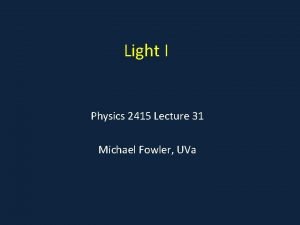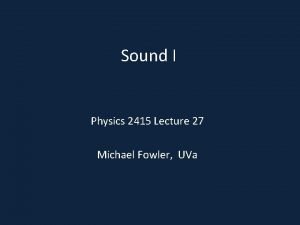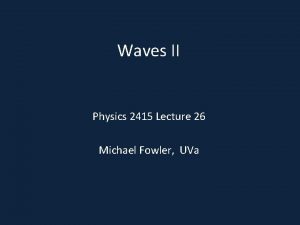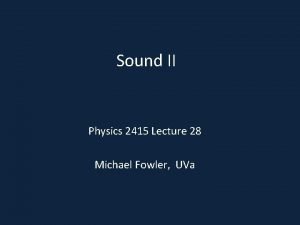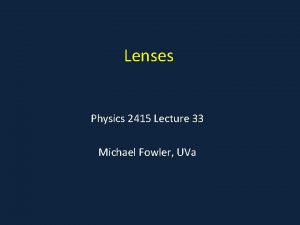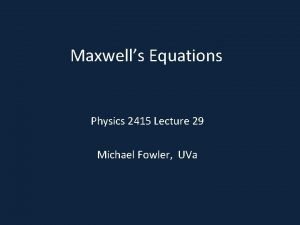Waves I Physics 2415 Lecture 25 Michael Fowler




![Dimensional Analysis: Mass on Spring • From F = -kx, • . [k] = Dimensional Analysis: Mass on Spring • From F = -kx, • . [k] =](https://slidetodoc.com/presentation_image_h/83d3f6438173dd118ffb826c453c0cce/image-5.jpg)








- Slides: 13

Waves I Physics 2415 Lecture 25 Michael Fowler, UVa

Today’s Topics • • Dimensions Wave types: transverse and longitudinal Wave velocity using dimensions Harmonic waves

Dimensions • There are three fundamental units in mechanics: those of mass, length and time. • We denote the dimensions of these units by M, L and T. • Acceleration has dimensions LT-2 (as in m/sec 2, or mph per second—same for any unit system). Write this [a] = LT-2. • From F = ma, [F] = [ma] so [F] = MLT-2.

Using Dimensions • Example: period of a simple pendulum. What can it depend on? • [g] = LT-2, [m] = m, [ℓ] = L. • What combination of these variables has dimension just T? No place to include m, and we need to combine the others to eliminate L: • [g/ℓ] = T-2, so is the only possible choice. • Dimensional analysis can’t (of course) give dimensionless factors like 2.
![Dimensional Analysis Mass on Spring From F kx k Dimensional Analysis: Mass on Spring • From F = -kx, • . [k] =](https://slidetodoc.com/presentation_image_h/83d3f6438173dd118ffb826c453c0cce/image-5.jpg)
Dimensional Analysis: Mass on Spring • From F = -kx, • . [k] = [F]/[x] = MLT-2/L = MT-2. • How does the period of oscillation depend on the spring constant k? • The period has dimension T, the only variables we have are k and m, the only combination that gives dimension T is , so we conclude that T. Spring’s force m Extension x

Waves on a String A simulation from the University of Colorado

Transverse and Longitudinal Waves • The waves we’ve looked at on a taut string are transverse waves: notice the particles of string move up and down, perpendicular to the direction of progress of the wave. • In a longitudinal wave, the particle motion is back and forth along the direction of the wave: an example is a sound wave in air.

Harmonic Waves • A simple harmonic wave has sinusoidal form: Amplitude A Wavelength • For a string along the x-axis, this is local displacement in y-direction at some instant. • For a sound wave traveling in the x-direction, this is local x-displacement at some instant.

Wave Velocity for String • The wave velocity depends on string tension T, a force, having dimensions MLT-2, and its mass per unit length , dimensions ML-1. • What combination of MLT-2 and ML-1 has dimensions of velocity, LT-1? • We get rid of M by dividing one by the other, and find [T/ ] = L 2 T-2 : • In fact, is exactly correct! • This is partly luck—there could be a dimensionless factor, like the 2 for a pendulum.

Sound Wave Velocity in Air • Sound waves in air are pressure waves. The obvious variables for dimensional analysis are the pressure [P] = [force/area] = MLT-2/L 2 = ML -1 T-2 and density [ ] = [mass/vol] = ML-3. • Clearly has the right dimensions, but detailed analysis proves where = 1. 4. • This can also be written in terms of the bulk modulus , but that differentiation must be adiabatic—local heat generated by sound wave pressure has no time to spread, this isn’t isothermal.

Traveling Wave • Experimentally, a pulse traveling down a string under tension maintains its shape: y vt x • Mathematically, this means the perpendicular displacement y stays the same function of x, but with an origin moving at velocity v: So the white curve is the physical position of the string at time zero, the red curve is its position at later time t.

Traveling Harmonic Wave • A sine wave of wavelength , amplitude A, traveling at velocity v has displacement y 0 x vt

Harmonic Wave Notation • A sine wave of wavelength , amplitude A, traveling at velocity v has displacement • This is usually written , where the “wave number” and. • As the wave is passing, a single particle of string has simple harmonic motion with frequency ω radians/sec, or f = ω/2 Hz. Note that v = f
 Michael fowler physics
Michael fowler physics Michael fowler physics
Michael fowler physics Michael fowler physics
Michael fowler physics Michael fowler physics
Michael fowler physics Michael fowler physics
Michael fowler physics 01:640:244 lecture notes - lecture 15: plat, idah, farad
01:640:244 lecture notes - lecture 15: plat, idah, farad Lowest point of a wave
Lowest point of a wave Light is an electromagnetic wave true or false
Light is an electromagnetic wave true or false Mechanical and electromagnetic waves
Mechanical and electromagnetic waves Similarities of mechanical waves and electromagnetic waves
Similarities of mechanical waves and electromagnetic waves What type of waves are sound waves? *
What type of waves are sound waves? * Sound is a longitudinal wave
Sound is a longitudinal wave Long waves and short waves
Long waves and short waves Difference between matter waves and electromagnetic waves
Difference between matter waves and electromagnetic waves
